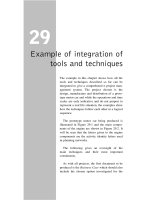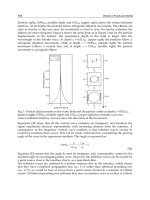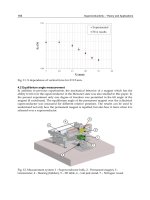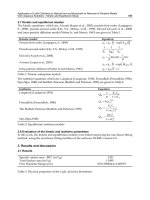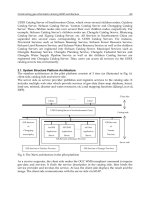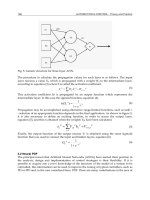Chapter 039. Nausea, Vomiting, and Indigestion (Part 8) pptx
Bạn đang xem bản rút gọn của tài liệu. Xem và tải ngay bản đầy đủ của tài liệu tại đây (14.73 KB, 5 trang )
Chapter 039. Nausea, Vomiting,
and Indigestion
(Part 8)
Table 39-3 Alarm Symptoms in GERD
Odynophagia
Unexplained weight loss
Recurrent vomiting
Occult or gross gastrointestinal bleeding
Jaundice
Palpable mass or adenopathy
Family history of gastrointestinal malignancy
Upper endoscopy is performed as the initial diagnostic test in patients with
unexplained dyspepsia who are >55 years old or have alarm factors because of the
elevated risks of malignancy and ulcer in these groups. The management approach
to patients <55 years old without alarm factors is dependent on the prevalence of
H. pylori infection in the local population. For individuals who reside in regions
with low H. pylori prevalence (<10%), a 4-week trial of a potent acid-suppressing
medication such as a proton pump inhibitor is recommended. If this fails, a "test
and treat" approach is most commonly applied. H. pylori status is determined with
urea breath testing, stool antigen measurement, or blood serology testing. Those
who are H. pylori positive are given therapy to eradicate the infection. If
symptoms resolve on either of these regimens, no further intervention is required.
For patients in areas with high H. pylori prevalence (>10%), an initial test and
treat approach is advocated, with a subsequent trial of an acid-suppressing regimen
offered for those who fail H. pylori treatment or for those who are negative for the
infection. In each of these patient subsets, upper endoscopy is reserved for those
who fail to respond to therapy.
Further testing is indicated if other factors are present. If bleeding is
reported, a blood count is obtained to exclude anemia. Thyroid chemistries or
calcium levels screen for metabolic disease, whereas specific serologies may
suggest celiac disease. For suspected pancreaticobiliary causes, pancreatic and
liver chemistries are obtained. If abnormalities are found, abdominal ultrasound or
CT may give important information. Gastric emptying scintigraphy is considered
to exclude gastroparesis in patients whose dyspeptic symptoms resemble
postprandial distress when drug treatment fails. Gastric scintigraphy also assesses
for gastroparesis in patients with GERD, especially if surgical intervention is
being considered. Breath testing after carbohydrate ingestion may detect lactase
deficiency, intolerance to other dietary carbohydrates, or small-intestinal bacterial
overgrowth.
Indigestion: Treatment
General Principles
For mild indigestion, reassurance that a careful evaluation revealed no
serious organic disease may be the only intervention needed. Drugs that cause acid
reflux or dyspepsia should be stopped if possible. Patients with GERD should
limit ethanol, caffeine, chocolate, and tobacco use because of their effects on the
LES. Other measures in GERD include ingesting a low-fat diet, avoiding snacks
before bedtime, and elevating the head of the bed.
Specific therapies for organic disease should be offered when possible.
Surgery is appropriate in disorders like biliary colic, while diet changes are
indicated for lactase deficiency or celiac disease. Some illnesses such as peptic
ulcer disease may be cured by specific medical regimens. However, as most
indigestion is caused by GERD or functional dyspepsia, medications that reduce
gastric acid, stimulate motility, or blunt gastric sensitivity are indicated.
Acid-Suppressing or Neutralizing Medications
Drugs that reduce or neutralize gastric acid are most often prescribed for
GERD. Histamine H
2
antagonists such as cimetidine, ranitidine, famotidine, and
nizatidine are useful in mild to moderate GERD. For severe symptoms or many
cases of erosive or ulcerative esophagitis, proton pump inhibitors such as
omeprazole, lansoprazole, rabeprazole, pantoprazole, or esomeprazole are needed.
These drugs, which inhibit gastric H
+
, K
+
-ATPase activity, are more potent than
H
2
antagonists. Acid suppressants may be taken continuously or on demand
depending on symptom severity. Many patients initially started on a proton pump
inhibitor can be stepped down to an H
2
antagonist. Combination therapy with a
proton pump inhibitor and an H
2
antagonist has been proposed for some refractory
cases.
Acid-suppressing drugs are also effective in appropriately selected patients
with functional dyspepsia. Meta-analysis of eight controlled trials calculated a risk
ratio of 0.86, with a 95% confidence interval of 0.78–0.95, favoring proton pump
inhibitor therapy over placebo. The benefits of less potent acid reducing therapies
such as H
2
antagonists are unproven.
Liquid antacids are useful for short-term control of mild GERD but are less
effective for severe disease unless given at high doses that elicit side effects
(diarrhea and constipation with magnesium- and aluminum-containing agents,
respectively). Alginic acid in combination with antacids may form a floating
barrier to acid reflux in individuals with upright symptoms. Sucralfate is a salt of
aluminum hydroxide and sucrose octasulfate that buffers acid and binds pepsin
and bile salts. Its efficacy in GERD is felt to be comparable to that of H
2
antagonists.

